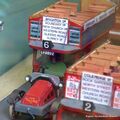Category:Tilling petrol-electric vehicles
The Tilling-Stevens petrol-electric bus was essentially an electric bus (with an electric motor), which, instead of being powered by batteries or external power via overhead cables, had its own onboard petrol-engined electrical generator. Although the system was not as energy-efficient as a conventional petrol-driven bus, the vehicles needed less specialised engineering with regard to gearboxes, and at a time when comparatively few people had experience of driving cars (and of operating manual gearboxes), the fact that the petrol-electrics were easy to drive made it easier to train bus drivers.
W.A. Stevens and Percy Frost-Smith
The W.A. Stevens company was started in 1897 by William Arthur Stevens, and produced a petrol-electric vehicle in 1906 based on a design by Percy Frost-Smith. The early vehicles were built on chassis made by J.E. Hall and Co., of Dartford (giving the Hallford-Stevens), and by Dennis Brothers of Guildford (giving the Dennis-Stevens).
Frost-Smith became Chief Engineer at Thomas Tilling Ltd. in 1905, working on petrol-engined vehicles, and designed a new petrol-electric vehicle for Tilling that entered service in 1909. With Frost-Smith onboard, the Tilling company became enthusiastic about petrol-electric vehicles and decided to commit to building a factory in Maidstone to produce the resulting Tilling-Stevens buses. Frost-Smith is supposed to have become Works Superintendent in 1912.
Since the petrol-electrics had been designed as road vehicles and had low-mounted components that weren't designed to cope with being driven over muddy fields, they were not considered suitable as army vehicles in World War One, and didn't experience a direct boost in production due to the war effort – instead, the company continued to focus on producing vehicles for the public transport sector.
decline
The case for the petrol-electric bus became progressively less compelling after WW1, as gearboxes and transmissions steadily improved in quality, reliability and efficiency, and as more people now knew how to drive a manual-gearbox vehicle.
Percy Frost-Smith continued to be a believer in the advantages of the petrol-electric concept, and continued to design and built improved versions after he left Tilling.
Niche markets
fairground vehicles
The petrol-electrics also became very popular with fairgrounds, as the onboard electrical generator could be used when the vehicle was parked to drive electric lights, electric musical organs and any of the fairground's other electrical equipment.
searchlight lorries
A further "niche" application appeared in wartime, when the vehicles were useful as mobile platforms for anti-aircraft searchlights, as the onboard electrical power plant meant that they didn't need to tow a trailer with a separate electrical generator to power the searchlight.
External links
- 1922 Tilling-Stevens TS3A Petrol-Electric Open top Double Deck Bus, reg. XL 1204 (bonhams.com)
- Tilling Stevens photos, Flickr (flickr.com)
- Tilling Stevens vehicles, National Fairground Archive (cdm15847.contentdm.oclc.org)
- Tilling Stevens buses (mtfca.com)
- Former Tilling-Stevens Factory, Maidstone (britishlistedbuildings.co.uk)
- "A New Petrol-Electric Chassis", Commercial Motor magazine, 3rd October 1922 (archive.commercialmotor.com)
Pages in category ‘Tilling petrol-electric vehicles’
The following 2 pages are in this category, out of 2 total.
Media in category ‘Tilling petrol-electric vehicles’
The following 4 files are in this category, out of 4 total.
- Thomas Tilling petrol-electric bus, early, angled (Ken Allbon).jpg 1,600 × 1,600; 762 KB
- Thomas Tilling petrol-electric bus, early, side (Ken Allbon).jpg 2,000 × 1,125; 1.18 MB
- Thomas Tilling petrol-electric bus, later, angled (Ken Allbon).jpg 2,400 × 1,713; 1.23 MB
- Thomas Tilling petrol-electric bus, later, side (Ken Allbon).jpg 1,800 × 1,014; 954 KB






